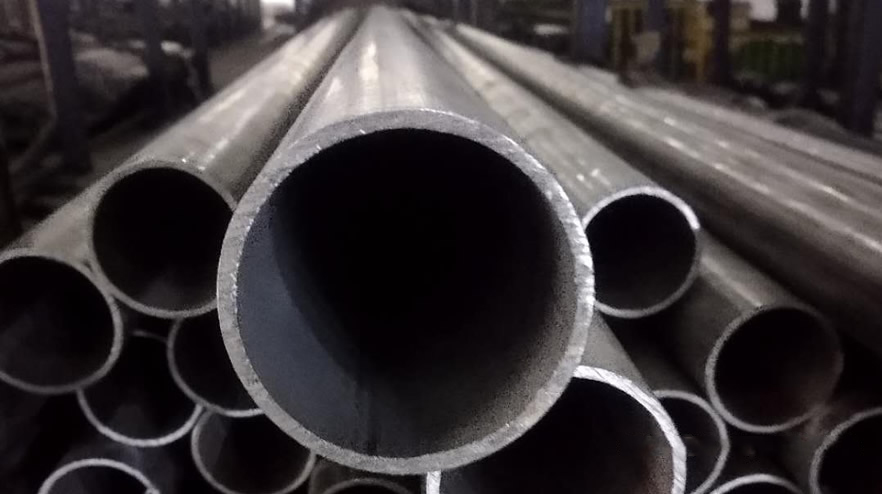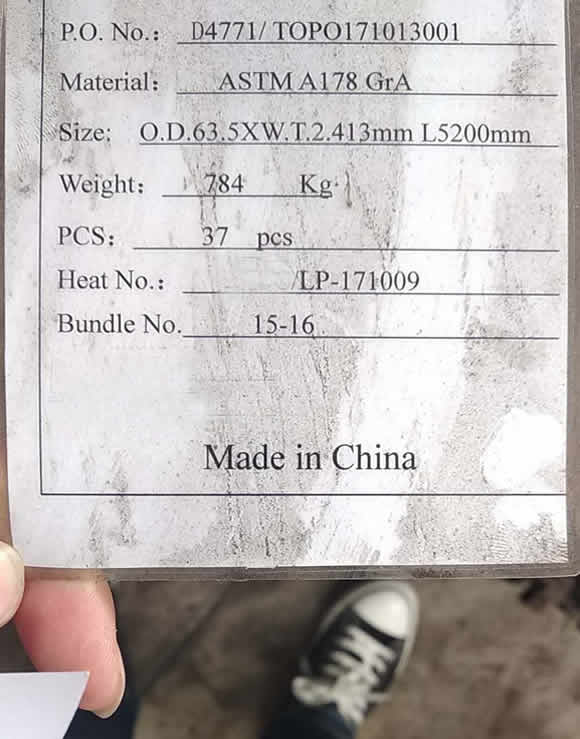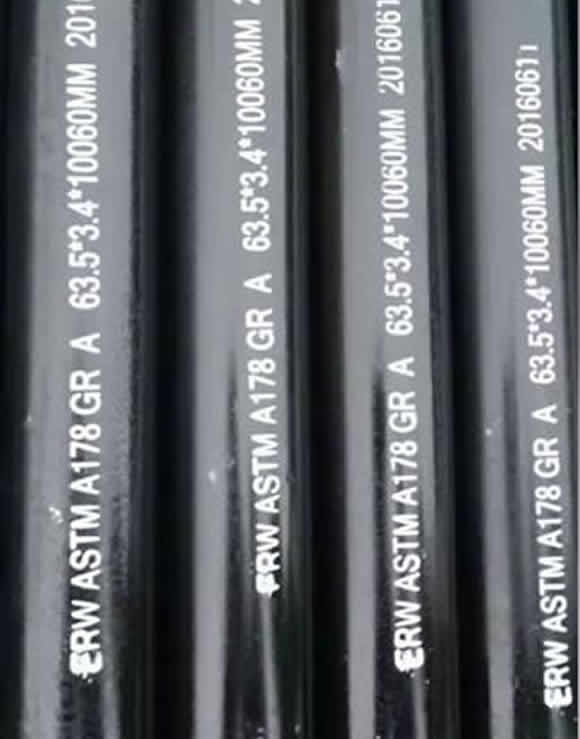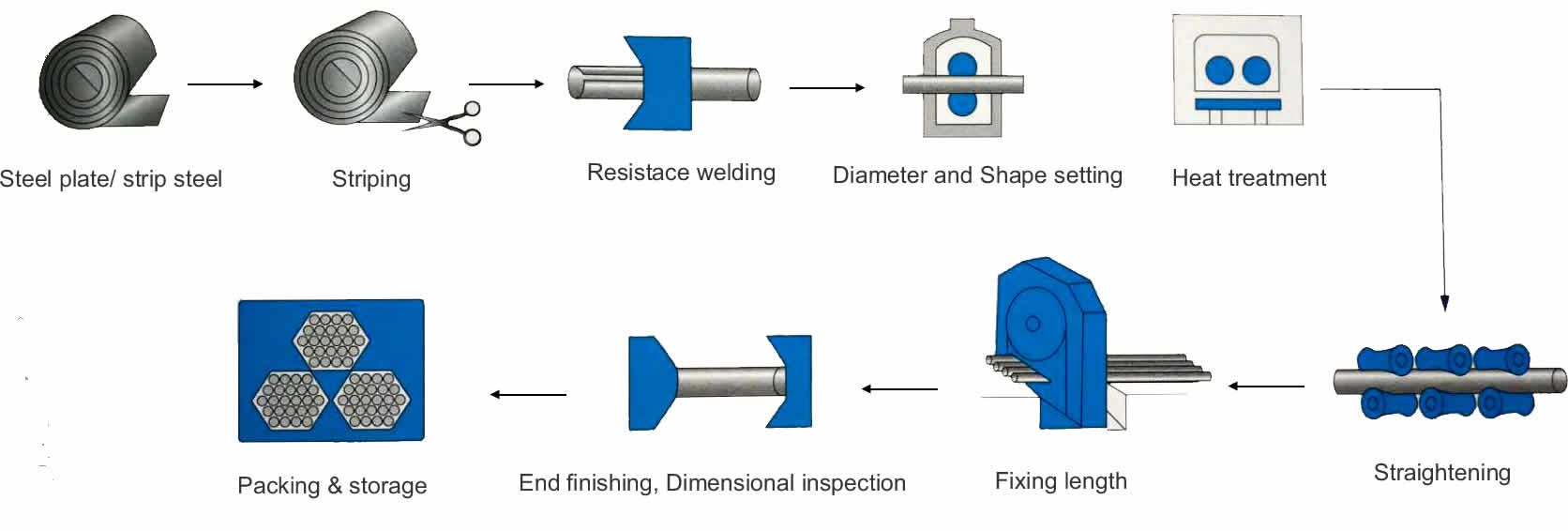Standard Specification for Electric-Resistance-Welded Carbon Steel and Carbon-Manganese Steel Boiler and Superheater Tubes

In stock

ASTM 178, Grade D Heat Exchanger Tube with plain end

ASTM A178 Grade D heat exchanger tube qualified products stacked
ASTM A178 standard referes to electric-resistance-welded tubes with minimum-wall-thickness. Materials are carbon steel and carbon-manganese steel, ASTM A178 pipe and tube is to be used in boiler tubes, boiler flues, superheater flues and safe ends.
Steel Grades A (low-carbon steel), C (medium-carbon steel), or D (carbon-manganese steel). Manufacturing processes must include heat treatment, welding after cooling. Crush test shall be performed if required by customer.

Paint on the pipe as per customer request

Marking as per customer's request
1.Scope*
1.1This specification2 covers minimum-wall-thickness, electric-resistance-welded tubes made of carbon steel and carbon-manganese steel intended for use as boiler tubes, boiler flues, superheater flues, and safe ends.
NOTE 1—Type C and D tubes are not suitable for safe-ending for forge welding.
1.2The tubing sizes and thicknesses usually furnished to this specification are 1⁄2 to 5 in. [12.7 to 127 mm] in outside diameter and 0.035 to 0.360 in. [0.9 to 9.1 mm], inclusive, in minimum wall thickness. Tubing having other dimensions may be furnished, provided such tubes comply with all other requirements of this specification.
1.3Mechanical property requirements do not apply to tubing smaller than 1⁄8 in. [3.2 mm] in inside diameter or 0.015 in. [0.4 mm] in thickness.
1.4Optional supplementary requirements are provided and when desired, shall be so stated in the order.
1.5The values stated in either inch-pound units or SI units are to be regarded separately as standard. Within the text, the SI units are shown in brackets. The values stated in each system are not exact equivalents; therefore, each system must be used independently of the other. Combining values from the two systems may result in nonconformance with the specifi- cation. The inch-pound units shall apply unless the “M” designation of this specification is specified in the order.
1 This specification is under the jurisdiction of ASTM Committee A01 on Steel, Stainless Steel and Related Alloys, and is the direct responsibility of Subcommittee A01.09 on Carbon Steel Tubular Products.
Current edition approved Sept. 10, 2002 . Published November 2002. Originally published as A 178 – 35 T. Last previous edition A 178/A 178M –95 (2002).
2 For ASME Boiler and Pressure Vessel Code applications see related Specifi- cation SA-178 in Section II of that Code.
3 Annual Book of ASTM Standards, Vol 01.01.
2.Referenced Documents
2.1ASTM Standards:
A 450/A 450M Specification for General Requirements for Carbon, Ferritic Alloy, and Austenitic Alloy Steel Tubes3
E 213 Practice for Ultrasonic Examination of Metal Pipe and Tubing4
E 273 Practice for Ultrasonic Examination of Longitudinal Welded Pipe and Tubing4
3.Ordering Information
3.1Orders for material under this specification should include the following, as required, to describe the desired material adequately:
3.1.1Quantity (feet, metres, or number of lengths),
3.1.2Name of material (electric-resistance-welded tubes),
3.1.3Grade (A, C, or D, Table 1),
3.1.4Size (outside diameter and minimum wall thickness),
3.1.5Length (specific or random),
3.1.6Optional requirements (product analysis, Section 7; crush test, Section 10; hydrostatic or nondestructive electric test, 11.6),
3.1.7Test report required (Certification Section of Specifi- cation A 450/A 450M),
3.1.8Specification designation,
3.1.9Individual supplementary requirements, if required, and
3.1.10Special requirements.
4.Manufacture
4.1The steel for Grade D shall be killed.
4.2Tubes shall be made by electric-resistance welding.
5.Heat Treatment
5.1After welding, all tubes shall be heat treated at a temperature of 1650°F [900°C] or higher and followed by cooling in air or in the cooling chamber of a controlled- atmosphere furnace. Cold-drawn tubes shall be heat treated after the final cold-draw pass at a temperature of 1200°F [650°C] or higher.
4 Annual Book of ASTM Standards, Vol 03.03.
TABLE 1 Chemical Requirements:
| Element % | Grade A | Grade C | Grade D |
| Low carbon steel | Medium Carbon Steel | Manganess Steel | |
| C | 0.06-0.18 | 0.35 Max | 0.27 Max |
| Mn | 0.27-0.63 | 0.80 Max | 1.00-1.50 |
| P | 0.035 | 0.035 | 0.030 |
| S | 0.035 | 0.035 | 0.015 |
| Si | ... | ... | 0.10 Min. |
Chemical Composition
The steel shall conform to the requirements as to chemical composition prescribed in Table 1.
When a grade is ordered under this specification, sup- plying an alloy grade that specifically requires the addition of any element other than those listed in Table 1 is not permitted.
Product Analysis
1. When requested on the purchase order, a product analy- sis shall be made by the manufacturer or supplier from one tube per 100 pieces for sizes over 3 in. [76.2 mm] and one tube per 250 pieces for sizes 3 in. [76.2 mm] and under; or when tubes are identified by heat, one tube per heat shall be analyzed. The chemical composition thus determined shall conform to the requirements specified.
2. If the original test for product analysis fails, retests of two additional lengths of flat-rolled stock or tubes shall be made. Both retests, for the elements in question, shall meet the requirements of the specification; otherwise all remaining material in the heat or lot (Note 2) shall be rejected or, at the option of the producer, each length of flat-rolled stock or tube may be individually tested for acceptance. Lengths of flat- rolled stock or tubes which do not meet the requirements of the specifications shall be rejected.
NOTE 2—A lot consists of 250 tubes for sizes 3 in. [76.2 mm] and under and of 100 tubes for sizes over 3 in. [76.2 mm], prior to cutting to length.


Tel:
E-mai:
Skype: